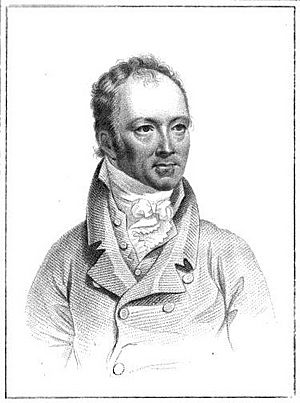James Caulfield facts for kids
James Caulfield (1764–1826) was an English author, printseller, publisher, and editor. He was known for collecting and publishing interesting historical accounts and portraits.
Contents
Early Life and Interest in Prints
James Caulfield was born in Clerkenwell, London, on February 11, 1764. His father was a music engraver, but James could not follow in his footsteps because of poor eyesight.
While in Cambridge for his health, James met Christopher Sharpe, who collected prints. Sharpe gave him some etchings and money to buy more. This sparked Caulfield's interest in prints, and he soon began bidding at print sales in Covent Garden.
Starting a Business as a Printseller
With support from his father, James Caulfield opened his own small shop in Old Round Court, Strand, where he sold prints. Famous people like Samuel Johnson and Richard Cosway even visited his shop.
In 1784, Caulfield helped his father engrave a large amount of music for a special event honoring the composer Handel. With the money he earned, he moved his shop to a larger place in Castle Street, Leicester Square. He moved again around 1795 to Clare Court, Drury Lane, and later to William Street, Adelphi, and then to Old Compton Street, Soho.
Collecting and Publishing Portraits
A book called Biographical History of England by James Granger (published in 1769) made collecting engraved portraits very popular. From 1814 to 1820, Caulfield focused on selling engravings, illustrating books, and creating catalogs. He worked with important collectors like Earl Spencer and Charles Towneley.
Later Years and Legacy
In his later years, James Caulfield continued to work as a cataloguer. He lived with his youngest daughter and her family. One of his sons, John Caulfield, also became a printseller and bookseller.
In January 1826, James Caulfield had an accident and broke his kneecap. He passed away on April 22, 1826, at St Bartholomew's Hospital. He was buried in his family's burial place in Clerkenwell Church. James was married to Mary Gascoigne, who died in 1816. They had seven children, and four of them lived longer than him.
Notable Works and Publications
James Caulfield was involved in publishing many interesting books. Here are some of his key works:
- Remarkable People: He published Portraits, Memoirs, and Characters of remarkable Persons (1794–5). This book featured stories and pictures of unusual and interesting people from history.
- The Oxford Cabinet: In 1797, he edited The Oxford Cabinet, which included old stories and facts about famous people.
- The New Wonderful Museum: He worked with William Granger on The new Wonderful Museum and Extraordinary Magazine (1803–1808), which was a collection of amazing stories and facts.
- Gunpowder Plot History: In 1804, he wrote The History of the Gunpowder Plot, about the famous attempt to blow up the Houses of Parliament.
- Londina Illustrata: He helped create Londina Illustrata (1805–25), a two-volume work with descriptions of London's buildings and places.
- Cromwelliana: In 1810, he edited Cromwelliana, which detailed events involving Oliver Cromwell from 1642 to 1658.
- Guide to Engraved Portraits: His book Calcographiana, Guide to the Knowledge and Value of Engraved British Portraits (1814) was about the business of selling prints.
- The Eccentric Magazine: He co-edited The Eccentric Magazine (1814), another collection of unusual stories.
- Kit-Cat Club Memoirs: In 1821, he wrote Memoirs of the celebrated Persons comprising the Kit-Cat Club, about a famous English club of writers and politicians.
- Granger's Biographical History: He also edited a new edition of James Granger's A Biographical History of England in 1824, adding many new biographies.


